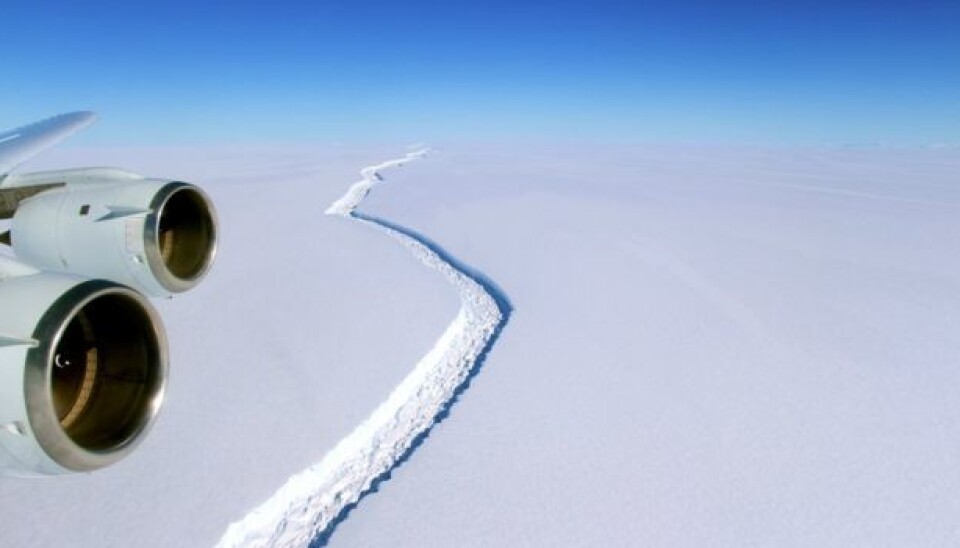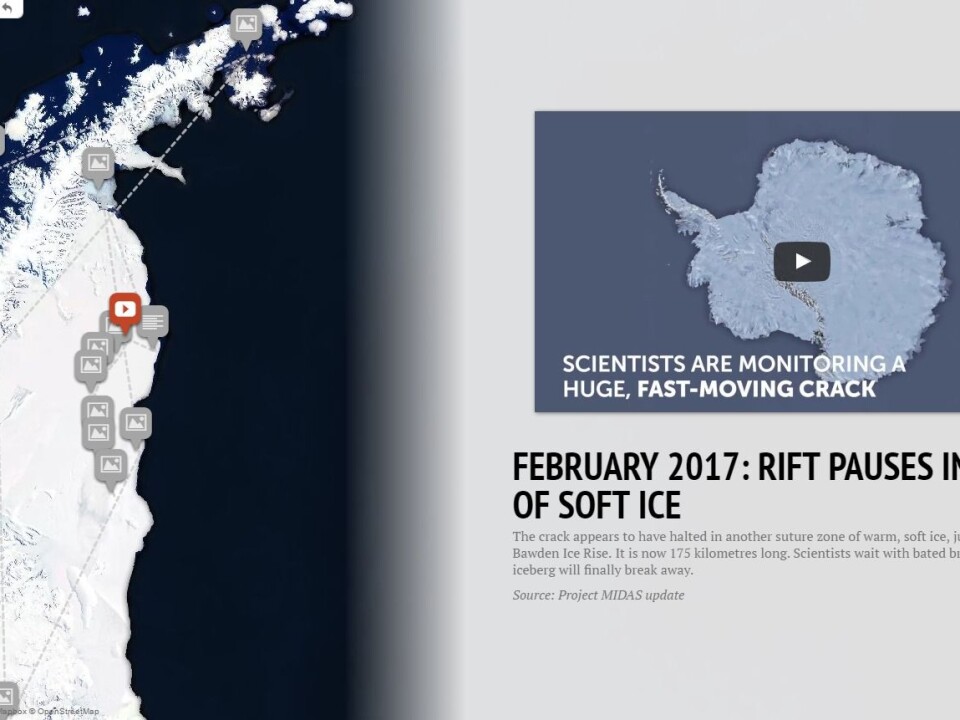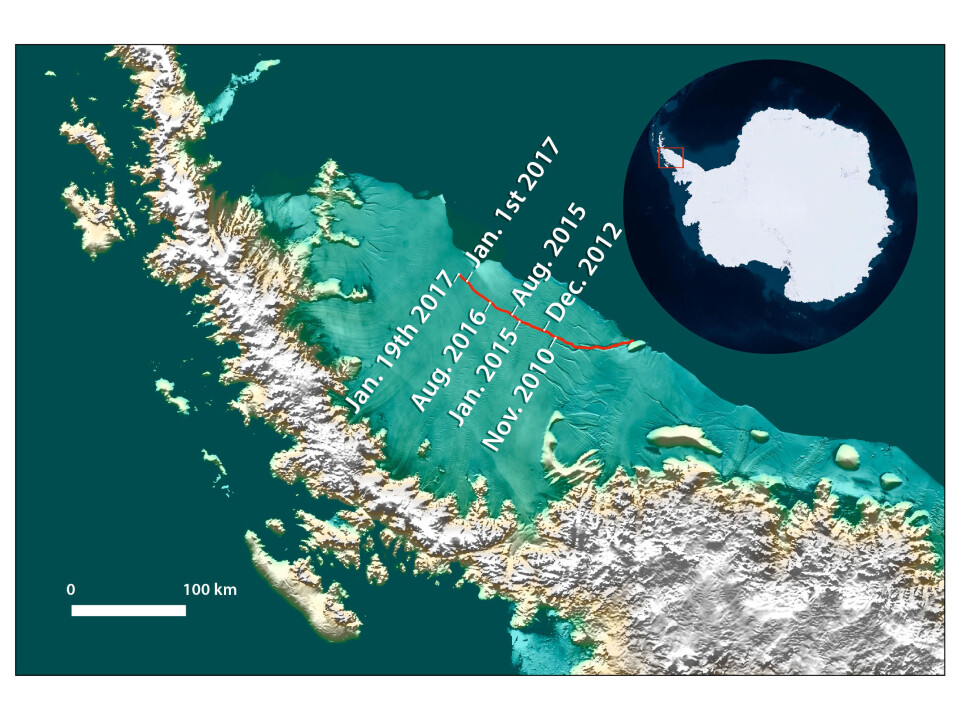
When will the large crack on this Antarctic ice shelf break away?
Scientists are closely monitoring a large crack spreading on the Larsen C ice shelf in Antarctica. Follow our interactive guide to see how the crack has developed.
A giant iceberg is about to break away from the Larsen C ice shelf in west Antarctica.
The fast progression of the now 175 kilometre long crack has had glaciologists around the world wondering when and how the ice will break away from the front of the ice shelf. It has just 20 kilometres left to go.
“It’s quite exciting. This is quite a long crack and it’s going to be a big iceberg,” says glaciologist Chris Borstad, associate professor at the University Centre in Svalbard (UNIS), Norway, who is one of the many glaciologists keeping a close eye on the crack.
The crack has been advancing rapidly since 2014 but suddenly picked up speed last year. At its fastest it advanced 18 kilometres in just two weeks in December 2016, and grew another ten kilometres in January this year.

“As the crack gets longer, there’s more leverage to pry it open. It’s a mechanical advantage—the longer the crack, the more force there is at the tip of the crack to continue to allow it to march forward,” says Borstad.
Scroll down to explore the interactive map of the Larsen C ice crack
UK project monitoring rift status
Scientists from Project MIDAS—a UK based Antarctic research project—have been monitoring the Larsen C ice shelf for the past two years. They predict that more than 5,000 square kilometres of ice will be lost when the rift finally opens up all the way. Borstand puts this closer to 6,000 square kilometres. That is as much as ten per cent of the current ice shelf area.
“This event will fundamentally change the landscape of the Antarctic Peninsula,” writes project leader Adrian Luckman, a professor in glaciology at Swansea University, UK, on the MIDAS project blog.

“We have previously shown that the new configuration will be less stable than it was prior to the rift, and that Larsen C may eventually follow the example of its neighbour Larsen B, which disintegrated in 2002 following a similar rift-induced calving event,” writes Luckman.
Read More: “Irreversible” glacier retreat in West Antarctica began 70 years ago
A natural event with possible links to climate change
Rifts like these are common occurrences on ice shelves across Antarctica, and its rapid advance cannot be directly attributed to climate change, says Borstad.
“Rifts like this occur, for example, where the ice pulls away from land. But cracks also form in other areas of ice shelves far from land,” says Borstad.
In fact there are lots of cracks in the same area of Larsen C, but none of them have grown in the same way as this one.
“There’s a whole family, you might say, of cracks lining up in the same area of the ice shelf. We still don’t know why this one particular crack grew beyond the point where the others have all stopped,” he says.
The ice could thin because it is being melted from below as the ocean warms. But that’s pure conjecture, says Borstad.
“Otherwise, these things happen periodically on ice shelves anyway, so it could just be sort of a random thing that was going to happen sooner or later,” says Borstad.
Read More: Elephant seals help scientists study climate change
Future stability of ice shelf in question
Borstad has recently submitted a paper in which he and his colleagues describe computer simulations of the crack’s possible development in the coming months. They outline different scenarios of what could happen to the rest of the ice shelf as a result.
The worst case scenario is that the crack reaches a point known as the Bawden Ice Rise, a pinning point at the northern part of the ice shelf. In this scenario the remaining ice shelf flows faster towards the sea, exerting even more force on the existing cracks in Larsen C.
“That’s a critical stabilisation point, and if that is removed then the ice shelf is definitely in trouble,” says Borstad.
The question now is whether this event will destabilise other fractures on the ice shelf and whether that will set in motion an irreversible retreat of the ice shelf. If this happens then the Larsen C could become unstable in the not too distant future, says Borstad.
Read More: Human-induced global warming began 180 years ago
Sea level will not rise when iceberg breaks away
When the iceberg finally calves away from the ice shelf, it will not cause global sea level to rise as the ice shelf is already floating. Just like an ice cube in a glass of water, the ice has already displaced it's volume.
But removing the front of the ice shelf could be more significant in the longer term, if Larsen C were to ultimately collapse.
If this happened, there would be nothing to hold back the glaciers on land from flowing into the sea, which could then cause sea level to rise. The BBC previously reported that the ice shelf holds back enough glacial ice to increase global sea level by as much as ten centimetres. But scientists at project MIDAS do not think it will be so dramatic. They estimate that any such rise in sea level is more likely to be on the scale of a few millimetres per year.
“Stitched” together ice brings rift to a standstill
But for now glaciologists are waiting to see when the iceberg will finally break away. And for all the sophisticated computer models, predicting precisely when this might happen is a mere guessing game.
“It’s difficult,” says Borstad. “While the speed has increased as [the crack has] gotten longer, it also pauses periodically when it reaches zones of softer ice.”
These soft zones of ice, called suture zones, form when two or more neighbouring glaciers meet and push up against each other. Eventually the bands of ice become “stitched” together as they continue to flow side by side towards the sea.
Something about these bands of ice makes them resistant to cracking, says Borstad. Every time the growing crack has encountered one of these zones its expansion has been halted.
“Right now it looks like it’s paused in the last big suture zone along its path,” he says.
Read More: Heavy summer rain in Greenland speeds up ice melt
Could break away tomorrow or next year
Satellite images of the ice shelf show that previous cracks in this particular suture zone have been stable for decades, though none of them are as big as the current rift.
So when does Borstad think the iceberg will finally calve away?
“I doubt it’ll be decades. It could go tomorrow, or it could be another year,” he says.
Borstad is planning a field trip to the ice shelf this year to further investigate how these suture zones halt ice cracks in their tracks. But this trip may be brought forward if the iceberg suddenly breaks away.
Learn more about the history of the rift, what is causing it, and what will happen once it finally breaks away, in our interactive map below.
Explore the interactive map to learn more about the development and current status of the Larsen C ice shelf. Use the "map overview" button in the top left to zoom out at any time. (Interactive graphic: Videnskab.dk / produced with StoryMaps / Satellite image from Mapbox.com)
Scientific links
- Kulessa et al. 2014. Marine ice regulates the future stability of a large Antarctic ice shelf. doi:10.1038/ncomms4707
- Jansen et al. 2015. Brief Communication: Newly developing rift in Larsen C Ice Shelf presents significant risk to stability. Doi:10.5194/tc-9-1223-2015



